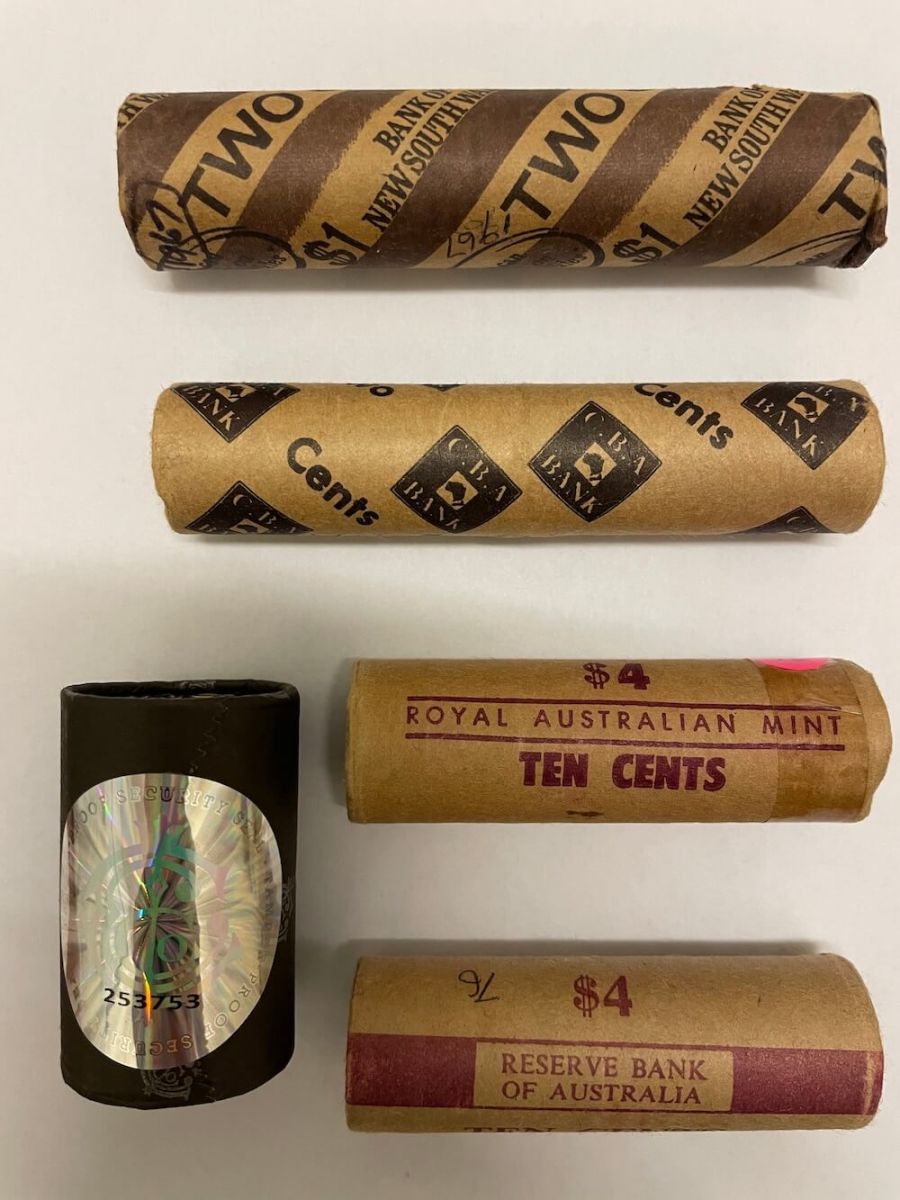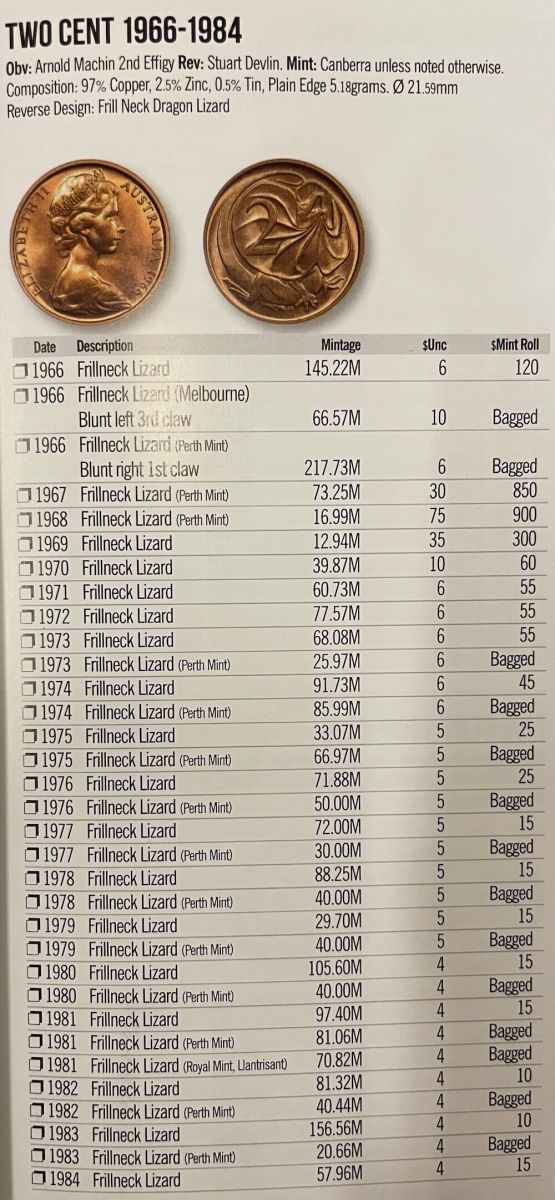Decimal Coin Rolls - A 50-Year-Old Market is Roaring

In 2024, the market for rolls of Australian decimal coin rolls is roaring - it's as strong now as it's ever been.
Although the practice of issuing circulating coins in rolls pretty much stopped way back in the 1990s, decimal coin rolls are so popular with collectors these days that the Royal Australian Mint releases a roll for most coins struck for circulation in 2024.
There are many reasons why decimal coin rolls are popular with collectors:
- If one coin is good, a roll of them is even better;
- There are many different types of mint rolls available to collectors;
- Prices are being determined solely by strong collector demand;
- Many decimal coin rolls are extremely scarce (especially in original condition);
- Even within the mintage for a particular denomination in a particular year, different types of roll are available;
- New research is being undertaken all the time that is bringing new information to light.
If One Coin Is Good, A Roll Of Them Is Even Better

If One Coin Is Good, A Roll Of Them Is Even Better
The market for Australian decimal coins has lifted in several stages since the first coloured 2-dollar coin was struck in 2012. There's no doubt coloured 2-dollar coins are the most popular coins being collected in Australia at the moment - they've captured the eyes and attention of people who had never considered collecting coins before.
The death of Queen Elizabeth II in September 2022 had people checking their change and setting coins aside more than ever before. That once-in-a-lifetime event had people setting commemorative coins aside "for the kids" at a pace that hadn't been seen since the introduction of decimal currency in 1966.
Many collectors have a rule - if one coin is good, a roll of them has to be even better. Many of the folks collecting coins today are setting aside coins because they're confident they'll be seen as being much rarer in years to come. In much the same way a keen punter on the horses will be happier with a larger bet than a smaller one, collectors or decimal coin rolls want to have as much exposure to potential rarities as they can get. This instinct is understandable - why not load up on a rare coin when it's cheap if it's going to be worth exponentially more in the future?
There Are Many Different Types Of Mint Rolls Available To Collectors

Different Types of Decimal Coin Rolls Are Available
Decimal coin rolls have been made in Australia since 1966, so over those 58 years, production processes, corporate brands and distribution methods have changed regularly.
There are several different types of coin rolls available to collectors, some of them are worth much more than others. These different types of roll are easily identified by the packaging used - there are rolls distributed by the Royal Australian Mint; by the Reserve Bank of Australia; by each of the private trading banks (Commonwealth Bank; Bank of New South Wales; Australia among others); by cash handling companies such as Armaguard and Prosegur and by private companies such as Cotton and Co in Brisbane.
Even back when the Royal Australian Mint was the only organisation with the authority to distribute circulating coins in rolls, I've seen different types of labels from the Royal Australian Mint for the same denomination and in the same year!
Most "normal people" (ie non-collectors) won't see any difference between two different types of roll, but when a difference is explained by a significant change in production method or indicates a rarer type, collectors seize on minor differences like that.
Then we come to the importance that collectors place on rolls that show either heads/tails, heads/heads or tails/tails. The OCD nature of most coin roll collectors is such that they want the heads side of a coin to be showing at one end and the tails side of a coin to be showing at the other. Some can tolerate a roll that has tails/tails showing at either end, others want to see rolls that have heads/heads showing at either end.
Yes, I do know several collectors that have been collecting coin rolls so actively for so long, that they're now actively seeking out one roll with each of those configurations - they know that each of those rolls have different values depending on what collectors are after at any point in time, but the thrill of the hunt is such they're keen to get one of each.
Prices Are Being Determined Solely By Strong Collector Demand
The market for decimal coin rolls really is emerging at the moment - although they've been released since 1966 (just like pre-decimal coins were before that), I struggle to think of one dealer that really dominates the market for them. This means the market for decimal coin rolls is de-centralised and spread across the entire country. A collector in Perth might be the first to have access to a particular type of coin roll, while collectors in Canberra might be the first to get the opportunity to acquire a coin roll that was distributed there.
Just because a collector doesn't have access to a roll first, doesn't mean they simply roll over and decide not to collect it. No! The lack of supply can drive some collectors to pay ever-increasing prices for the coin rolls they want to add to their collections. When more and more collectors enter the market, prices rise in response. In a market like this where naked competition rules the day, prices can't be set by dealers and price expectations can't be managed by figures in a price guide. Check the prices for any specific roll in a numismatic auction or on eBay and you'll see prices being paid that bear no relationship to the current catalogue value. A collector that keeps to themselves and sets their ideas about value and rarity based on what they see (or more to the point don't see) with their own eyes, they could care less what theoretical number is in a book, they'll pay whatever they think is fair to add that roll to their collection.
Markets like this are the perfect expression of the open market - values rise and fall according to demand and supply.
Many Decimal Coin Rolls Are Extremely Scarce (Especially In Original Condition)

New Information Is Coming to Light
Although the mintage of any decimal coin is generally measured in millions rather than thousands, some decimal coin rolls are extremely scarce, especially in original condition.
Nearly all of the coin rolls that are issued are busted open by people and businesses to use in their daily lives, so it really is an unusual situation when a coin roll survives the demands of economic activity. Couple that with the fact that some coins are made in relatively limited numbers and further that some rolls are scarce relative to the mintage of the coins included, more than a few decimal coin rolls are extremely hard to come by. This is one of those areas of Australian numismatics where if we think we can buy whatever coins we want just by throwing money at the problem, we can straight up forget about building a complete collection! A complete collection really needs investigative skills and the hunter's instinct as well as ready funds. Finding a scarce coin roll and adding it to a collection is a very satisfying experience.
Even Within The Mintage For A Particular Denomination In A Particular Year, Different Types Of Roll Are Available
Just when we think we understood the type of roll that was issued for a particular denomination in a particular year, we can see there's a different type of label we didn't know about before! I haven't studied this series deep enough yet to learn why and how these differences came about, but I'm convinced there are other collectors out there that now exactly why there are 2 (or more) different labels on some rolls that were issued in the same year.
New Research Is Being Undertaken All The Time That Is Bringing New Information To Light
As more collectors come into the market, many of them have burning questions about why certain differences in roll exist, and why some are rarer than others. This means that a collection of rolls put together decades ago might include a rarity that has lain dormant ever since then. The right information can add value to rolls that others might think are quite normal - this type of fresh interest in the series makes it an exciting area to be involved with.
I believe as this research continues, there'll be a push sooner or later to have the main price guide updated.
The Rennik's Price Guide to Australian Coin and Banknote Values is an excellent book that outlines this series (well, it's the only book!). While it does list each year a roll was released, it doesn't indicate which rolls were released by the Royal Australian Mint and which rolls were released by the Reserve Bank of Australia as an example.
Based on what I can see of recent sales on eBay and via numismatic auctions, the prices included haven't been revised comprehensively for some years. If the price guide is updated so it reflects actual market activity, when the average collector sees that jump (and for some rolls it will be a massive jump), then its not inconceivable that demand will take another leg up as more and more collectors take an interest in them.
Not only is the market for decimal coin rolls in 2024 roaring, it really could be the start of a whole new market.